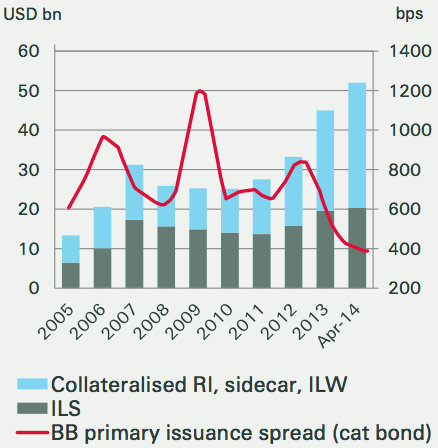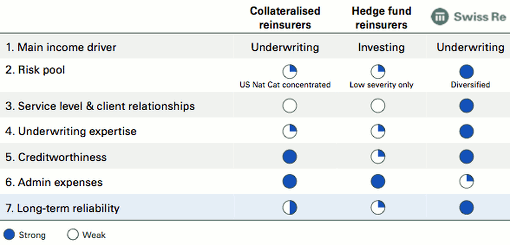Swiss Re, one of the largest reinsurance groups in the world, believes that alternative capital is not a replacement for the traditional reinsurance model according to its CEO Michel M. Liès in a statement released this morning.
In the update from the reinsurer, released in advance of its investor day being held in London today, Liès says that clients are expected to continue to rely on reinsurers for services and long-term support, but that the reinsurer does not believe that alternative reinsurance capital will replace its role in the marketplace.
It’s an interesting statement at this time, especially given none of the alternative capital players Artemis speaks with would actually believe that Swiss Re is going to be replaced by third-party capital and insurance-linked securities (ILS) completely.
Of the many conversations we have with market participants about the possible death of the traditional reinsurance model, none conclude that Swiss Re, or any other reinsurer of its size, is about to fail. In fact most of these conversations conclude that the level of service, underwriting expertise and skill at a reinsurer like Swiss Re is essential to both the traditional model and the alternative models future.
However, with an investor day looming where questions are sure to arise as to the impact of ILS and alternative capital, it seems clear that Swiss Re felt it had to respond in advance to set the tone with this statement mentioning alternative capital. Might that backfire a little and result in more of a focus on alternative capital at its investor day than the reinsurer would have wanted? That’s surely now a real possibility.
No one can dispute the scale and expertise of reinsurers like Swiss Re, nor the fact that they are unlikely to fail, or disappear due to the currently competitive market and threat posed from alternative capital and ILS. However, what almost everyone would agree with is the fact that reinsurers like Swiss Re will have to adapt, may have to reduce their costs of capital to compete and also that traditional reinsurers could eventually lose certain parts of the reinsurance business to ILS and more efficient sources of capital.
Some of Swiss Re’s presentations at the investor day will see it try to demonstrate why it is preferable for a client relationship over alternative capital.
Swiss Re believes that alternative capital now has a 23% share of the U.S. catastrophe reinsurance market and puts total alternative capital, in the form of collateralized reinsurance, ILS and sidecars at approximately $52 billion, with $20 billion of that ILS and the rest collateralized reinsurance structures.
In the investor presentation Swiss Re notes that cat bond spreads have declined by around 40% in the last 18 months but have more recently stabilised in recent weeks.
Some of this alternative capital is here to stay, the presentation says, but it is not likely to replace the traditional natural catastrophe reinsurance market. This is interesting, as some might say that Swiss Re would be well served to leave certain areas of property catastrophe to alternative capital in order to leverage its lower cost, while focusing on growth in other areas where the traditional reinsurer model is better suited, but the reinsurer does not choose this direction in its argument.
Swiss Re notes that clients rely on the traditional reinsurance scale of services and support, something that no-one is disputing and even the ILS managers and direct collateralized competitors would not deny.
The chart below showing the estimated size of the alternative reinsurance capital market and how catastrophe bond spreads have declined is taken from Swiss Re’s presentation.

Estimated size of global AC market that is focusing on Nat Cat vs cat bond spread - Source: Swiss Re
Swiss Re is also sceptical of alternative reinsurance capital which focuses on longer-tailed lines of reinsurance business. It says that those reinsurers looking to write long-tail, low-volatility business, with higher combined ratios and boosted by more aggressive investment strategies carry substantial risks for clients.
The reinsurer notes that for these hedge fund strategy reinsurers, the liabilitities they underwrite are not fully collateralized despite the high-risk investment strategy. Swiss Re also notes that the attrition rate for hedge funds is significantly higher than the attrition rate for reinsurers, reaching as high as 30% in 2008 (perhaps not the best year to compare).
Swiss Re’s presentation today will focus on its ability to outperform through scale, service, expertise and innovation. Again, that is not in dispute and never has been. However some might dispute Swiss Re’s ability to remain competitive in all areas of the reinsurance market.
Swiss Re explains its competitive position with a graphic showing what it believes are its strong points versus alternative or collateralised reinsurers and hedge fund reinsurers.

Swiss Re business model vs collateralized and hedge fund reinsurers
Swiss Re implies that collateralized reinsurance players, so ILS managers and funds, and hedge fund reinsurers lack in underwriting expertise and have low service levels and lesser client relationships, also that they are less reliable over the long-term.
ILS funds, collateralized markets and hedge fund backed reinsurers, in Artemis’ experience, are actually extremely focused on developing strong relationships with clients and see origination by themselves as a key feature. Also the service provided, in terms of what is required, seems strong.
Granted, Swiss Re has scale, sophistication, expertise in-depth etc, but again no-one was debating that fact, apart perhaps from Swiss Re itself.
On the subject of long-term reliability, the collateralized nature of the covers in ILS and alternative capital would seem to make the protection they provide at least as reliable over the duration of the business underwritten. Whether the same capital will still be there in 20 years time is not possible to know, but perhaps that is more down to a change in the way business is done these days, rather than anything detrimental.
Swiss Re is not to be blamed for going on the offensive to be defensive here, times are uncertain for the traditional reinsurance model. Swiss Re says that we are in a softening phase of the reinsurance market, but that it expects to continue to outperform with its differentiated service model and P&C strategic initiatives.
Swiss Re also notes that its expected long-term ROE for property and catastrophe reinsurance remains in the range of 10% to 15%. While ROE’s such as that are achievable Swiss Re should expect to continue to compete with the capital markets, alternative capital, ILS and hedge fund reinsurers, as that is an attractive return for a lower-cost source of capital and explains why it faces a competitive environment in the first place.
 View all of our Artemis Live video interviews and subscribe to our podcast.
View all of our Artemis Live video interviews and subscribe to our podcast.
All of our Artemis Live insurance-linked securities (ILS), catastrophe bonds and reinsurance video content and video interviews can be accessed online.
Our Artemis Live podcast can be subscribed to using the typical podcast services providers, including Apple, Google, Spotify and more.































